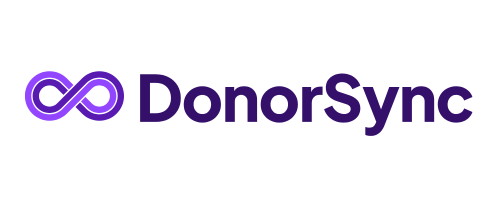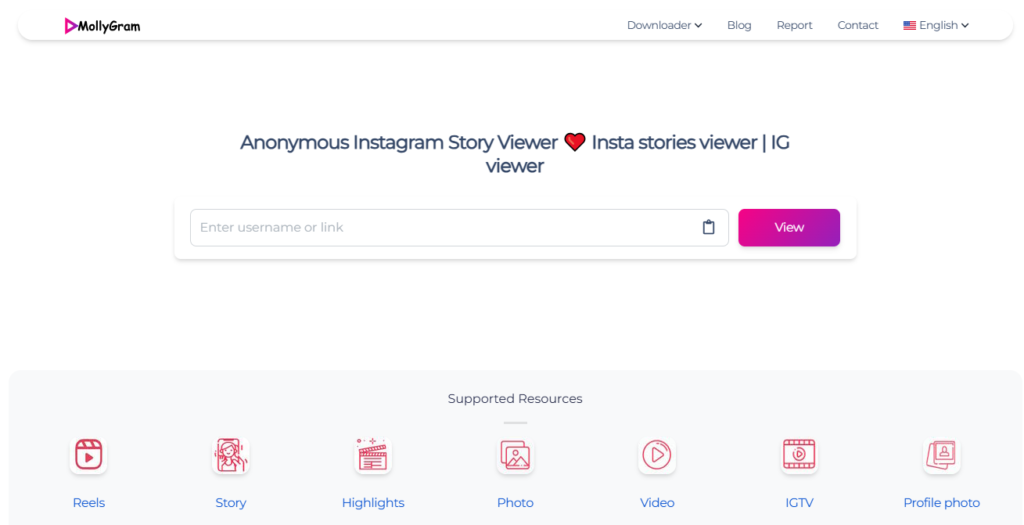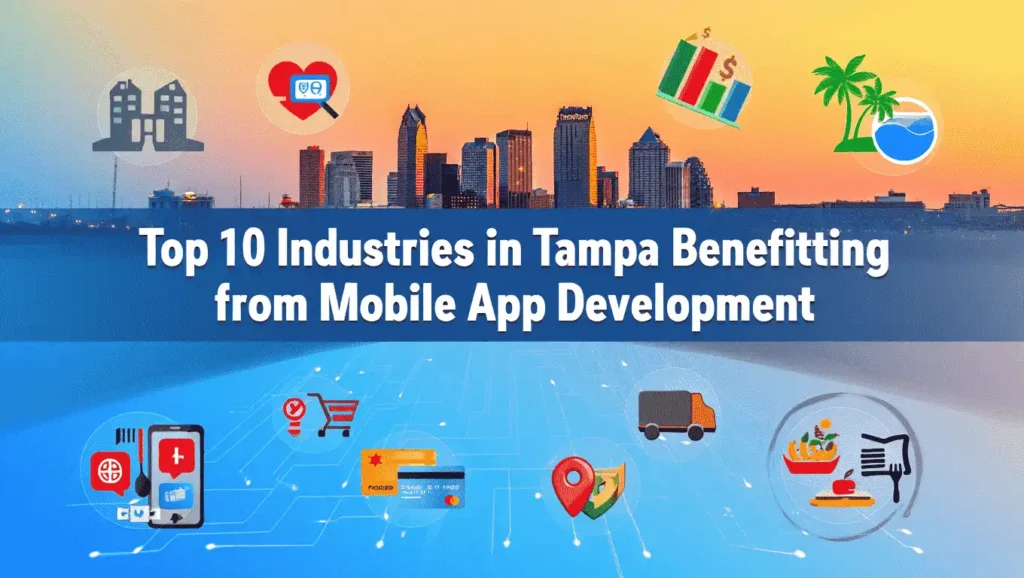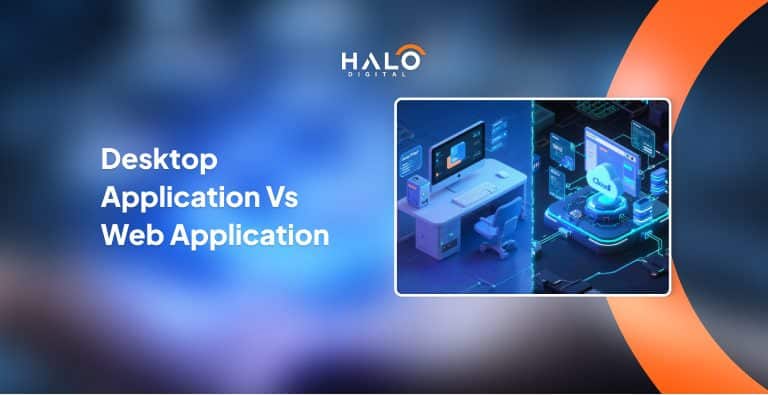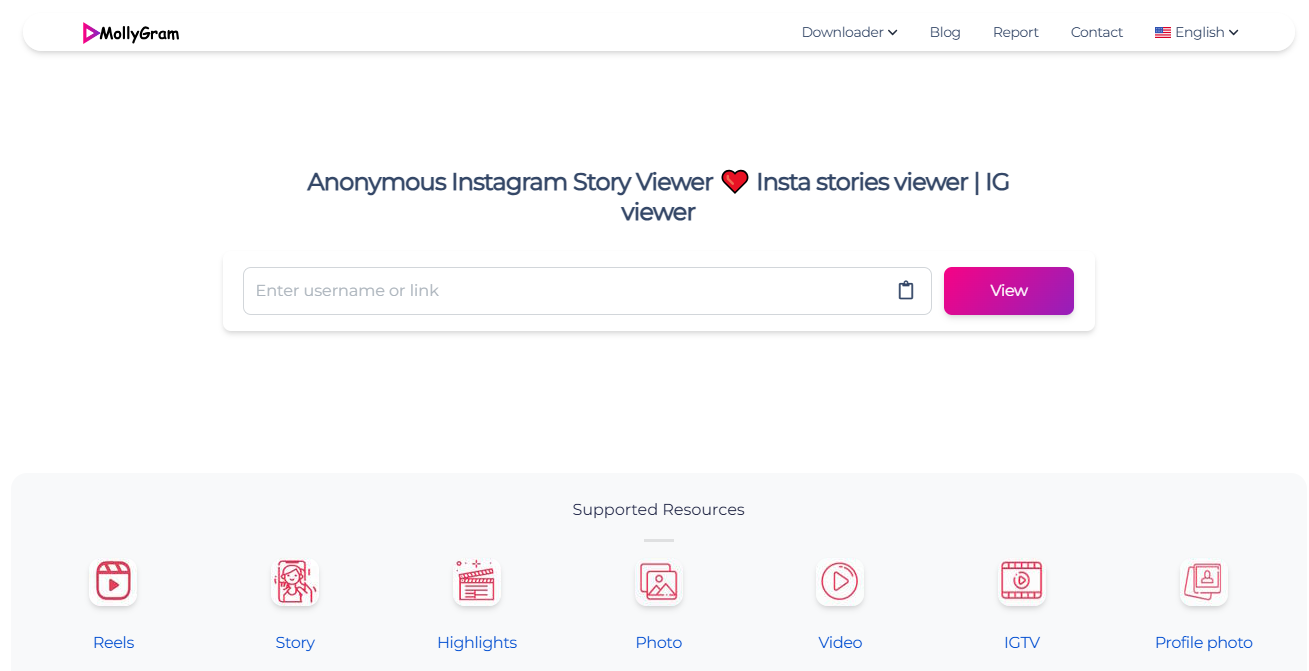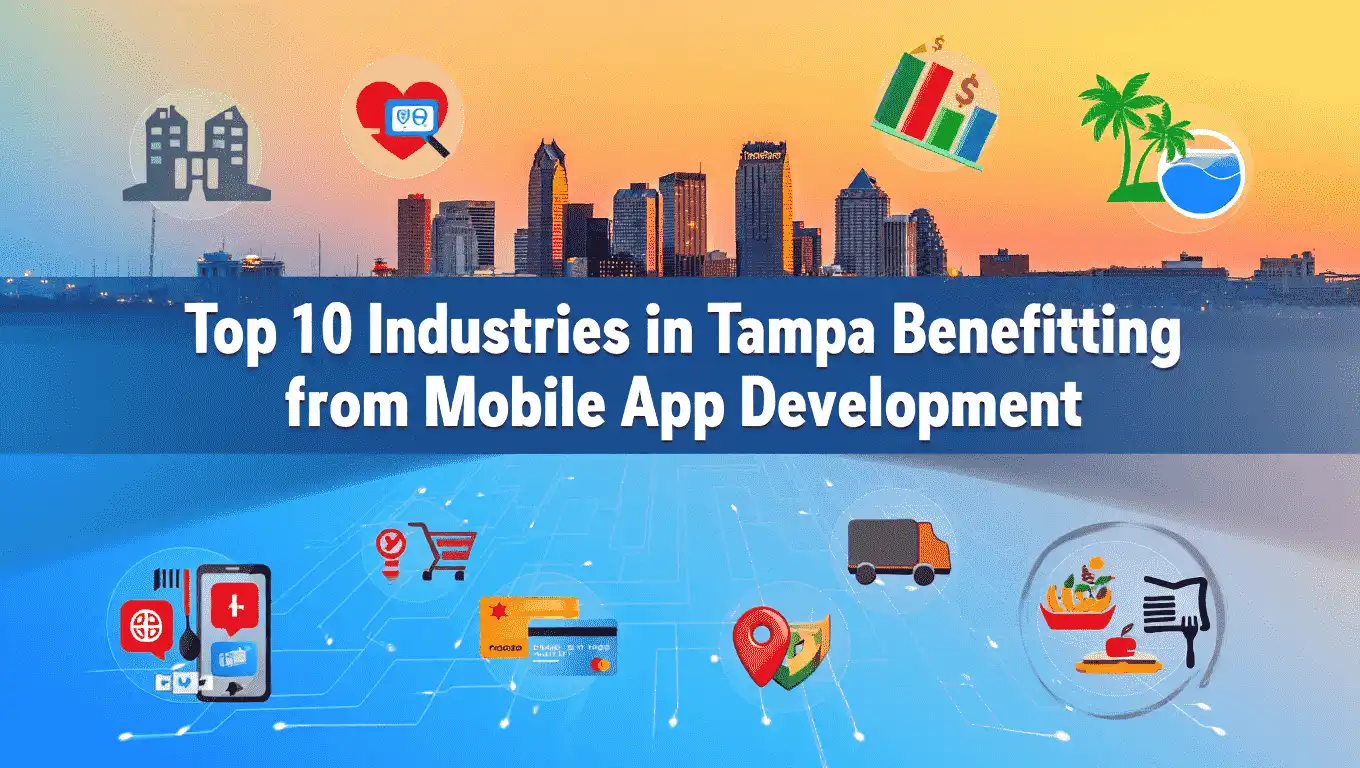- Desktop applications offer better performance, offline access, and deeper system control but require installation, manual updates, and strong hardware.
- Web applications provide easy access from any device, automatic updates, and lower hardware demands but rely on a stable internet connection.
- Web apps are generally more scalable and cross-platform, making them ideal for remote teams, collaboration, and cloud-based workflows.
- Desktop apps are better suited for heavy processing tasks like design, video editing, engineering tools, or environments needing strict local data control.
- The right choice depends on your use case, performance needs, security requirements, and how widely your users need to access the application.
When deciding between a desktop application vs web application, it’s important to understand how each type works and their respective benefits.
In 2023, 48% of global organizations hosted their applications, databases, and services in a cloud service, while 45% hosted them locally. This indicates a significant reliance on web-based platforms for business operations.
Whether you’re choosing between desktop vs web-based applications or looking to understand the difference between web application and desktop application with examples, this guide covers it all.
We’ll walk through the desktop application vs web application pros and cons, helping you choose the right fit for your business needs.
From performance to accessibility, we’ll break down everything you need to know about web-based vs desktop applications.
What Is a Desktop Application?
A desktop application is software installed directly on a computer’s hard drive and runs without an internet connection. Examples include Microsoft Word, Adobe Photoshop, and Spotify. Desktop apps offer better performance and full control over the system but require manual installation and updates.
What Is a Web Application?
A web application is software that runs on a web browser and requires an internet connection. Examples include Google Docs, Facebook, and Trello. Web apps are accessible from any device with a browser, offering convenience and easier updates without the need for installation.
What’s the difference between a web application and a desktop application with examples?
A web application runs in a browser and requires an internet connection (e.g., Google Docs, Facebook). A desktop application is installed on your computer and works offline (e.g., Microsoft Word, Adobe Photoshop). Web apps offer easy access across devices, while desktop apps provide better performance and offline functionality.
Key Differences Between Desktop and Web Applications
Feature / Aspect | Desktop Application | Web Application |
Installation | Requires installation on individual devices | No installation; accessed through web browsers |
Platform Compatibility | Often OS-dependent (e.g., Windows, macOS) | Cross-platform; works on any device with a browser |
Performance | High performance; uses full system resources | Depends on internet and browser capability |
Offline Access | Fully functional without internet | Requires internet connection to function |
Updates | Must be manually updated by the user | Automatically updated by the provider |
Data Storage | Data stored locally; more user control | Data stored on servers/cloud |
Security | Controlled locally; more privacy | Dependent on server-side security and encryption |
Maintenance | User responsible for software and system updates | Low maintenance for users; handled by provider |
Customization | Highly customizable to system capabilities | Limited customization due to browser restrictions |
Cost Efficiency | One-time payment or license fee; minimal ongoing costs | Often subscription-based; ongoing operational costs |
Accessibility | Limited to the installed device | Accessible from anywhere with internet |
Use Cases | Ideal for resource-heavy tools (e.g., video editing, CAD) | Perfect for collaboration tools, e-commerce, CRM platforms |
Scalability | Difficult to scale across multiple devices quickly | Easily scalable across users and locations |
Installation Requirements
A major difference between desktop applications and web applications is their installation process.
Desktop applications require users to download and install the software on their system, which can be a hassle, especially for large teams or enterprises. In contrast, web applications run directly through a web browser, eliminating the need for installation.
This makes web apps more accessible for startups or small businesses that want easy access without worrying about installation issues. However, desktop apps can provide deeper integration with the system, offering better performance for certain tasks.
Platform Dependency and Compatibility
Another difference is platform dependency. Desktop applications are often designed for specific operating systems, meaning a Windows app may not work on Mac or Linux without modifications.
On the other hand, web applications are generally cross-platform, accessible from any device with a browser, making them more versatile across diverse environments.
For companies with teams using multiple operating systems, this flexibility can be a huge advantage. For example, services like Google Docs are a prime example of how web apps seamlessly function on various platforms.
Updates and Maintenance
Desktop applications often require manual updates, where users must download and install the latest version themselves. This can lead to inconsistencies in performance, especially across large organizations.
In comparison, web-based applications automatically update in real-time, ensuring everyone has access to the latest features and improvements without manual effort.
This is particularly useful for startups and SMBs that don’t have dedicated IT teams for constant updates, while desktop apps may be preferred for environments where control over updates is crucial.
Accessibility and Internet Dependency
The web application vs desktop application debate also revolves around accessibility.
Web applications require an internet connection to function, as they rely on cloud servers to store data and perform tasks. This can be a limitation in areas with unstable internet, but it allows for easy access from any device.
In contrast, desktop applications can function offline, which is beneficial in situations where internet access is intermittent or unreliable, such as in remote locations.
For organizations that need to operate in both connected and offline environments, this can be a significant factor in choosing between the two.
For companies developing browser-based tools, following the important UX rules for B2B web applications ensures that even cloud-reliant software offers a seamless and intuitive user experience, especially in business-critical environments.
Security Considerations
Security is another important consideration. Web applications are more vulnerable to cyber threats because they transmit data over the internet, making them a potential target for hackers.
However, they are often updated automatically, ensuring the latest security patches are applied. Desktop applications, on the other hand, store data locally, which can reduce exposure to online threats.
But they also require users to manually install updates and ensure their systems remain secure. For businesses and organizations handling sensitive data, understanding these risks and implementing proper security protocols is crucial when deciding between desktop vs web applications.
What Are the Pros of Desktop Applications?
Offline Accessibility
One of the major benefits of desktop applications is the ability to function without an internet connection.
Unlike web-based applications, which rely on an internet connection for access, desktop apps can operate fully offline, making them ideal for environments where internet connectivity may be unreliable or intermittent.
For example, a desktop word processor like Microsoft Word can be used anywhere, whether on a plane or in a remote area. This provides great flexibility, especially for businesses operating in locations with limited or no internet access, a crucial advantage for many SMBs or enterprises with on-the-go workers.
Optimized Performance
When comparing desktop application vs web application performance, desktop apps often have the upper hand in terms of speed and responsiveness. Since these applications are installed directly on the device, they can leverage local system resources like RAM and CPU more effectively.
This means desktop applications can run complex processes faster without being limited by internet speed or browser performance. For example, graphic design software or high-performance games are more efficient on desktop systems compared to web-based applications due to their ability to optimize hardware utilization.
More Control Over Data and Privacy
With desktop applications, you have more control over your data and privacy compared to web applications.
Since all data is stored locally on the device, businesses can implement their own security measures, reducing the reliance on third-party cloud services. This is particularly important for industries dealing with sensitive or regulated information, such as healthcare or finance.
For instance, desktop applications for accounting or legal software often allow companies to maintain full control over their data without having to worry about potential breaches through a cloud-based service. This gives businesses a sense of security when handling confidential information.
Customization Flexibility
Another big plus for desktop applications is the ability to tailor them to specific needs. Unlike web-based applications, which are more standardized, desktop apps often offer more customization options.
Whether it’s adjusting the user interface, integrating with other local software, or modifying features to suit a business’s workflow, desktop applications are highly flexible. This customization can lead to increased productivity and better results, especially for enterprises with specific requirements.
Reliable Performance with Heavy Tasks
For businesses that rely on heavy applications, such as video editing or 3D rendering, desktop applications offer the reliability needed to manage complex tasks. Since the application runs directly from the machine’s hardware, it can better handle high processing requirements.
Web-based applications, on the other hand, might struggle with heavy files or tasks due to limitations in browser processing power. This makes desktop apps ideal for industries like media production, architecture, or engineering where resource-heavy programs are frequently used.
What Are the Cons of Desktop Applications?
Need for Installation and Space
While desktop applications have many advantages, one downside is the requirement for installation.
Unlike web-based applications, which can be accessed directly through a browser, desktop apps need to be downloaded and installed on each device, which can be time-consuming. Additionally, they take up valuable storage space on the computer.
This could be problematic, especially for organizations that rely on multiple systems and devices.
For businesses with limited storage space or SMBs with many employees, managing installations can become cumbersome compared to the simplicity of web applications that don’t require local storage.
Manual Updates
Another downside of desktop applications is that they typically require manual updates. Unlike web applications, which are automatically updated by the service provider, desktop apps need users to check for updates and install them themselves.
This can lead to inconsistencies in performance across different users within an organization, especially if updates are missed or delayed.
While desktop applications offer more control, the responsibility for keeping the software up-to-date falls on the user, which can sometimes lead to security risks if not managed properly.
Limited Cross-Platform Support
When considering desktop vs web-based application flexibility, desktop apps often fall short in terms of cross-platform compatibility. Desktop applications are typically designed for a specific operating system, whether it’s Windows, macOS, or Linux.
This means users on different platforms may not have access to the same tools unless separate versions of the software are developed. In contrast, web-based applications are inherently cross-platform, accessible on any device with a web browser.
This limitation makes desktop applications less appealing for businesses with diverse tech environments, especially when compared to the universal accessibility offered by web apps.
Dependency on Device Performance
Another downside of desktop applications is their reliance on the device’s hardware.
Since the app runs locally, its performance can be significantly impacted by the machine’s specifications.
If your team’s computers have outdated or limited hardware, it could result in slow performance or even crashes.
In comparison, web-based applications offload a lot of processing to the cloud, meaning they’re less reliant on local device performance.
For businesses with employees using older systems, this can be a significant drawback of desktop apps.
Compatibility Issues with Updates
One common issue with desktop applications is that new updates may not always be compatible with previous versions.
For example, older operating systems may not remote support software the latest app updates, leading to software malfunctions.
This is a pain point especially in industries where legacy systems are still in use. Unlike web-based applications, which are updated universally for all users, desktop applications sometimes face compatibility issues, resulting in disruptions and additional costs for updates or replacements.
What Are the Pros of Web Applications?
Easy Access Across Devices
One of the standout benefits of web applications is the ability to access them from any device with a browser and internet connection.
Whether you’re using a desktop, laptop, tablet, or smartphone, you can work seamlessly across different devices.
This makes web-based applications incredibly flexible, especially for businesses with employees on the go or teams that need to collaborate remotely.
For example, Google Docs allows users to access and edit documents from any device, ensuring smooth and continuous workflows.
This cross-device accessibility is a key factor for organizations that prioritize remote or hybrid work models.
Self-Updating and Maintenance-Free
Unlike desktop applications, which require manual updates and installations, web applications are updated automatically by the service provider.
Users don’t have to worry about downloading new versions or patches, as updates happen in the background. For businesses, this means less IT intervention and fewer disruptions.
Popular tools like Slack or Zoom automatically update without user involvement, ensuring you always have the latest features and security patches.
This self-updating nature keeps operations smooth, particularly for small businesses or startups with limited IT resources.
Cross-Platform Compatibility
Web applications are designed to run smoothly across all major platforms, including Windows, macOS, iOS, and Android. For businesses that need more advanced performance or tailored mobile functionality, Halo Digital serves as a trusted custom mobile app development company in USA, helping teams build high quality mobile experiences that perfectly complement their web applications.
This makes them a reliable choice for organizations with a diverse mix of devices and operating systems.
Unlike desktop applications, which may only work on one specific platform, web apps are universally accessible.
For example, a project management tool like Trello works effortlessly on different devices and operating systems, making it a preferred option for teams that use varied hardware.
The inherent cross-platform compatibility increases flexibility for teams working in a multi-device environment.
Reduced Hardware Requirements
Another significant advantage of web applications is that they don’t place heavy demands on your device’s hardware.
Since most of the processing happens on the server side, your device only needs a browser and internet connection to run the app.
This reduces the strain on your computer’s resources, making web apps ideal for users with low-spec devices or businesses operating on a tight budget.
For instance, applications like Google Sheets can run smoothly on most devices, without requiring powerful CPUs or large amounts of RAM, offering cost-effective alternatives to heavy desktop software.
Centralized Data and Easy Collaboration
Web applications often store data on cloud servers, meaning teams can access the same data from anywhere, at any time.
This centralized approach facilitates collaboration, as multiple users can work on the same document or project in real-time, often built on strong CMS development services foundations.
Tools like Microsoft 365 or Google Workspace are prime examples, allowing teams to update documents and track progress instantly, ensuring everyone stays on the same page.
For businesses that rely on constant collaboration, web applications provide the scalability and accessibility needed to streamline operations.
What Are the Cons of Web Applications?
Requires Constant Internet Connection
One of the biggest drawbacks of web applications is their reliance on a stable internet connection.
Unlike desktop applications, which can function offline, web apps need an active internet connection to operate.
This dependency can be problematic for users in areas with unreliable internet access or during network outages.
For instance, cloud-based software like Google Docs may be inaccessible if there’s no internet connection, disrupting workflows.
This constant connectivity requirement can be a challenge for businesses with employees working remotely in areas with poor internet infrastructure.
Performance Issues on Low-Bandwidth Connections
When the internet connection is slow or unstable, the performance of web applications can significantly degrade.
These apps depend on data transmission between the client and the server, which can result in slow load times, lag, and frustrating user experiences on low-bandwidth connections.
For example, video conferencing tools like Zoom may struggle to provide clear audio and video if the internet connection is weak.
This makes web applications less effective in regions or environments where internet speed is a limiting factor, impacting productivity and user satisfaction.
Security Concerns with Data Transmission
Since web applications transmit data over the internet, they can be vulnerable to security risks such as hacking, data breaches, or man-in-the-middle attacks.
Even with encryption and other security measures in place, the nature of online communication exposes data to potential risks.
For example, sensitive customer data stored on platforms like Salesforce could be targeted by cybercriminals if not properly protected.
This is why businesses must invest heavily in robust security measures to safeguard data. Web-based applications can, therefore, raise concerns over the protection of confidential information compared to locally stored desktop applications.
Limited Customization Options
While web applications offer flexibility, they often come with limitations in terms of customization.
Since they are built to work across a wide range of devices and platforms, it can be harder to tailor them to specific business needs.
For example, while project management tools like Asana or Trello offer a range of features, users may find them restrictive when compared to a desktop application that allows full customization of workflows and interface.
For businesses requiring highly specialized features, this lack of customization can be a drawback, especially if they need to integrate deeply with other in-house systems.
Dependency on Server Reliability
Another downside of web-based applications is their dependence on the service provider’s server uptime. If the server goes down or experiences technical issues, all users are affected, and the application becomes temporarily unavailable.
This is in contrast to desktop applications, which are hosted locally and can continue functioning regardless of external server issues.
For example, if a cloud-based CRM like HubSpot experiences server downtime, businesses relying on that service will face interruptions in their operations.
This reliance on the service provider’s infrastructure introduces potential risks, especially for businesses that depend heavily on continuous access to their applications.
How to Choose Between a Desktop or Web Application?
Choosing between a desktop or web application depends on your specific needs—and often fits within broader software development services strategies that define your long-term tech roadmap.
Desktop applications are best for offline access and high-performance tasks, while web applications offer easy accessibility, cross-platform compatibility, and simplified maintenance.
If you need to access software from anywhere with an internet connection, a web app is the way to go, whereas desktop apps are better suited for tasks requiring intensive processing on a single device.
Use Cases for Desktop Applications vs Web Applications
Enterprise Solutions
For large-scale enterprises, desktop applications may offer better control over performance and security.
Applications that require significant data processing and are used on secure internal networks, such as specialized accounting or design software, may be more suited to the desktop environment.
However, web-based applications have been growing in popularity for enterprise solutions as they provide greater flexibility, cross-platform compatibility, and remote accessibility.
Cloud-based enterprise tools like Salesforce or Google Workspace allow businesses to collaborate globally without worrying about operating system compatibility or installing software on every device.
E-commerce Platforms
For e-commerce platforms, web applications are the clear winner.
Businesses often require tailored ecommerce development solutions to build secure and scalable storefronts.
They allow customers to browse, purchase, and track orders from any device with an internet connection, providing a seamless shopping experience.
Desktop applications may be less convenient for e-commerce as they require installation and can only be accessed on the specific device where they are installed.
Websites like Amazon or Shopify show the power of web applications, enabling businesses to reach a global audience without worrying about device compatibility or installation issues.
This is exactly the reason why many businesses in Baton Rogue and other cities are now opting for custom web application development services.
Remote Work Tools
In the era of remote work, web applications are essential for team collaboration.
Tools like Slack, Zoom, and Microsoft Teams are web-based and facilitate communication, file sharing, and project management from anywhere in the world.
They can be accessed from any device with a browser, allowing employees to work from home or on-the-go.
Desktop applications, while still used for specific tasks, are less flexible for remote work due to their requirement for installation on individual devices.
For example, an employee working remotely would need to install an accounting desktop app, while they can simply log into an online tool for collaboration without needing anything installed.
Custom Web Application Services That Fit Your Business
At Halo Digital, our web application services are built around real business needs — not one-size-fits-all templates.
We create powerful, scalable web apps that serve startups, enterprises, NGOs, and everything in between.
Whether you’re streamlining operations, launching a new product, or solving a unique challenge, we design solutions that actually work.
Let’s build something smart, secure, and future-ready — together.
FAQs
Should I build a desktop or web application?
It depends on your needs. Choose a desktop app for high performance and offline access, or a web app for easy access, scalability, and cross-platform use.
Is a website a desktop application?
No, a website is not a desktop application. Websites run in browsers online, while desktop apps are installed and run locally on a device.
What are two benefits of using a web application instead of a desktop application?
Web applications offer easier access from any device and no need for manual updates, making them more flexible and low-maintenance.
What is the difference between an application and a web application?
An application can be any software (desktop, mobile, or web), while a web application specifically runs in a browser and needs internet access.
Which language is used for desktop applications?
Languages like C++, Java, Python, and C# are commonly used to build desktop applications depending on the platform and performance needs.
Conclusion: Desktop Application Vs Web Application
The future of desktop and web applications really comes down to what users need and how tech keeps evolving.
Desktop apps aren’t going anywhere—they’re still the best choice for tasks that demand power, speed, or offline access.
But web apps are clearly gaining ground, especially for businesses that need flexibility, easy updates, and access from anywhere.
With things like Progressive Web Apps (PWAs), the line between the two is getting blurrier. At the end of the day, it’s not about which one is better overall—it’s about which one makes the most sense for your goals and users.

Abdullah Mangi is an SEO strategist and content writer with 5 years of experience helping businesses grow online. He writes about programming, tech, online business, and practical how-to topics. Abdullah has worked with clients in SaaS, software development, web design, link building, yacht rentals, gardening, car rentals, and recruitment.






